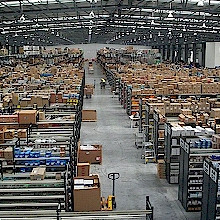
Logistics - Always The Bridesmaid But Never The Bride
Scan the latest industry research reports and one could quickly be convinced that logistics has never been more poised to enhance its efficiency. Never been so ready to adopt the latest information technology tools available to it. Indeed, on reviewing the Deloitte Touche Consulting survey results released late last year, one leading US industry commentator was so inspired as to conclude that "the age of supply chain management has arrived".
Paradoxically, however, when one digs just a little below the surface, the reality would seem to be very different. In fact, it is easy to conclude that what so much ongoing research is reflecting is rhetoric rather than reality. Well considered aspirations rather than anything like achievable results.
What is more, it is hard to escape the view that it is senior management that is effectively keeping logistics in the dark ages. So that while logistics itself has been long and clearly committed to vastly streamlining their operations, it is those at the top of the corporate ladder who are undoubtedly blocking the much needed and readily achievable progress.
And lest anyone is left in any doubt about this last complaint being the rule rather than the exception, consider again that recent Deloitte Touche survey. This showed that 75% of the logistics and manufacturing respondents to that consulting group’s review, expressed dissatisfaction with their companies’ present IT. Some 50% noted that they would buy software applications additional to ERP to provide the necessary support to their supply chain strategies. With an even more pointed 75% specifically noting the need for warehouse management systems.
But surely, it could well be asked, do not such unequivocal and focussed responses clearly show logistics management’s absolute commitment to installing state of the art new systems? And do they not equally demonstrate that today’s supply chain professional is more than conversant with advanced technology and the advantages that it can bring to their responsibilities?
The answer to both questions is a solid yes. However, with a very big ‘But!’ added.
To explain that view, let us take a circuitous route and first begin by visiting the Deloitte survey in just a little more detail. This additionally showed, for example, that 80% of manufacturers said that they will launch a major supply chain initiative in the next 12 months. Some 97% ranking supply chain management as being of pivotal importance to their companies’ long term success.
The enabling technology seen as being necessary for this was also reviewed, with respondents nominating their intention to implement the following applications over the next two years.
Software Propose to have In 2 Years
Source: Deloitte & Touche Consulting Group
Warehouse Management Systems 37%
Performance Measurement 39%
Production Scheduling 27%
Freight Payment 24%
Distribution Scheduling 37%
Transport Management 34%
Capacity Planning 32%
Maintenance 29%
Supply Chain Optimisation 53%
From a software vendor’s viewpoint alone, such a set of intentions must surely come close to a picture of nirvana. And it is an inventory of objectives that well warrants that enthusiastic comment that "the age of supply chain management has arrived".
But has it? Is there any real likelihood that such a high level of advanced systems implementation will actually occur? If past performance is any guide then that answer has to be no.
Consider, for instance, some research which had an almost identical focus. Conducted jointly by WERC (the Warehouse Education & Research Council) and Ohio State University, that study looked at how logistics executives then planned to boost the competitiveness of their companies. Top of the agenda were the dual goals of achieving shorter customer order lead times and attaining much higher rates of accuracy in those orders. Most significantly,
‘The Use of Automation’ was clearly listed in its own right, although clearly only as the means through which the other objectives could be achieved.
Reviewing such a picture, it is impossible not to accept that logistics practitioners themselves have for quite some time readily embraced the imperatives of high technology, fully understood its application to their operations, and been clear as to the substantial benefits it can deliver. It must equally be accepted that something is clearly standing in the way of the bulk of those professionals being able to implement their plans and install the systems they are clearly indicating they both need and want.
Identifying the reason – indeed assigning the blame – for this sobering scenario does not pose anything at all like a challenge.
In short, and wherever one cares to look, the fault can be squarely laid at the doors of senior corporate management.
In reality, and being totally clinical, there is little doubt that things will change and that progress will be inevitable. In the short term this will still be slow, painfully slow by many peoples’ standards. However it will be progress none the less.
After all, while it is all too easy to reflect on those organisations who are ignoring IT in the supply chain, let us not forget those logistics operations which have been allowed to embrace new technology. Such players are clearly demonstrating the very substantial advantages that flow from the take up of new software tools and methodologies.
These benefits have been examined by, among others, the independent and highly respected Gartner Group. And taking their analysis of warehouse management systems as but one example, real life users experience is said to demonstrate the following corporate gains.
Benefits of Warehouse Management Systems
Source : Gartner Research
Inventory accuracies approaching 99.9%
Inventory reductions of up to 50%
Direct labour savings of up to 40%
Indirect labour savings of up to 15%
Space utilization increases of 20%
Physical inventory execution costs eliminated
Shipping accuracies of 98% plus
Confronted with such compelling evidence, it will become increasingly hard for senior management to go on ignoring the potent cost/benefit arguments being depicted. For sure, they may well elect to still overlook, or arbitrarily discount, the recommendations of their own warehousing and distribution people. Such is the inevitability of the ‘prophet in ones own land’ syndrome. However they will find it much harder to summarily dismiss the experience of their peer group, particularly so when those contemporaries are direct competitors. As the latter are able to substantially enhance customer service while markedly reduce logistics costs, doing something simply to catch up on lost ground will become an urgent imperative.
For instance, all too many supply chain managers see their IT department colleagues as interfering enemies rather than valuable allies. As technical propeller-heads who have absolutely no idea of logistics, as opposed to senior executives who have an enviable track record of getting new computer projects well and truly on the corporate agenda.
So use these self same individuals to help prepare the cost/justification for a mooted logistics IT proposal and it is far more likely to get well beyond first base. It will certainly be presented in the format most likely to garner chief executive attention. While, as a byproduct, there will now be two teams of people championing the cause not just one.
Next, its important for logistics to immediately take its cost justifications and forcefully sell them to the other people in the company who will clearly benefit from what is proposed. Demonstrate to sales management, for instance, just how effectively customer service will be enhanced. Stress the extent to which lead times will be reduced. Highlight the reduction in shipping errors that will ensue. And even show sales how it can depict the efficiencies of its distribution centre to help win new business from major accounts.
Similarly, demonstrate to marketing how the warehouse will be far better equipped to handle the added sales volumes that are generated by such things as new product launches and special sales promotion campaigns.
A final recommendation suggests that logistics quite deliberately harnesses the range of talents that can be extracted from vendors of the software products in question. Use these organisations’ experience both in the preparation of the mooted project’s justification and then in professionally and forcefully presenting this to management. Certainly vendors’ staff will bring an element of bias and self interest to the table. Equally though, they are likely to be singularly experienced in such endeavors. Most importantly, they have a very comprehensive understanding of precisely how their product works and how this has effectively been applied to a diverse range of logistics environments. So marry their knowledge of their product to logistics knowledge of its own company and a rather formidable team is put in place.
That said, rather too many supply chain executives can be seen to still shy clear of such hands on involvement of vendor sales and industry specialist personnel. They seem to think that letting such people loose within their company or on their management will somehow weaken their own control, responsibility and authority.
However if these and the other noted resources are mustered and successfully choreographed, the likelihood is that the industry may well be surprised at the extent to which its IT aspirations do become a reality.
It may well be that a not too distant survey then shows the majority of organizations are in the category of firms with effective logistics systems, having formally graduated from that of those still looking to the future.





